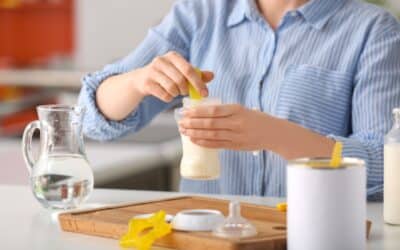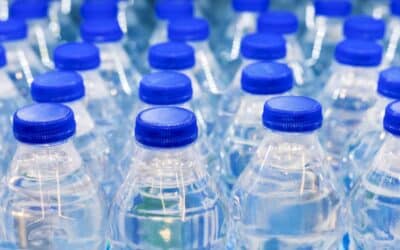Water – it is essential to life, forming a vital part of our daily needs and bodily functions. The guidelines on water consumption are frequently discussed for adults, with the ubiquitous advice to drink eight glasses a day. But what about the tiniest members of our family? With their delicate systems and rapid growth, babies have unique hydration needs distinct from older children and adults.
As they transition from relying solely on milk to integrating solid foods, many parents wonder: How much water should a baby drink? This article delves into the intricacies of a baby’s hydration needs, offering guidance based on age, developmental stages, and other factors. Whether you’re a new parent or simply curious, join us as we navigate the essential world of water for babies.
Newborns (0-1 month of age)
For newborns, especially those within their first month of life, the primary beverage for their sustenance and hydration is either breast milk or formula. The American Academy of Pediatrics strongly recommends exclusive breastfeeding for the initial months of a baby’s life, but in situations where breastfeeding is not feasible, infant formula serves as a suitable alternative.
Why isn’t water recommended at this young age? It’s essential to understand that, during these initial weeks, babies get all the hydration they need from breastmilk or formula. Contrary to what some might think, there isn’t a need for babies to drink water. In fact, drinking water isn’t just unnecessary for babies younger than one month—it can be harmful.
There are several risks associated with giving baby water during this period:
1. Water Intoxication: This is a real concern for young babies. Their kidneys are still developing and can’t handle a large volume of water. Drinking even a small amount can dilute the level of sodium in the baby’s bloodstream, leading to water intoxication. Symptoms might include a drop in body temperature, swelling, and in severe cases, seizures.
2. Impact on Nutritional Intake: When babies drink water, they might consume less breast milk or formula, depriving them of essential nutrients. Drinking water could lead to weight loss and malnutrition.
It’s also worth noting that many parents consider introducing other liquids, like fruit juice or artificially sweetened drinks, during this period. The American Academy of Pediatrics advises against this. These sugary drinks, including flavored milk and sports drinks, are not suitable for babies. They can lead to weight issues, tooth decay, and could alter the baby’s developing palate.
So, when can babies start having water? As babies transition to solid foods, typically around 6 months of age, they can begin taking small sips of water to help develop their cup drinking skills. However, sippy cups, straw cups, and even open cups should be introduced with caution and in limited quantities. It’s always best to consult a pediatrician when considering introducing water or any other beverages to your baby’s diet.
Infants (1-6 months of age)
Continued Reliance on Breast Milk or Formula
During the first six months of a baby’s life, their primary source of nutrition and hydration remains breast milk or baby formula. The American Academy of Pediatrics continues to emphasize that breastmilk or formula should be the central part of an infant’s diet in these initial months. Whether bottle feeding or nursing, ensuring babies drink enough breast milk or properly mixed formula is crucial for their growth and development.
Introducing Water: Small Sips and Caution
While babies primarily rely on breast milk or formula, there might be instances where a parent wonders: when can babies drink water? Typically, around the six-month mark, coinciding with the introduction of table food or when babies start solids, small sips of plain water can be introduced.
1. When and How Much? For young babies between 1-6 months, if a pediatrician gives the go-ahead, it’s best to limit their water intake to a few sips during hot days or if constipation is a concern. This should be done using an open cup or a sippy cup.
2. Safety Considerations: It’s crucial to ensure the water is clean. Boiled water, cooled to room temperature, is often recommended to ensure any potential pathogens are killed. Tap water in some areas, like Orange County, undergoes rigorous disease control and is safe, but always consult local guidelines.
3. Beware of Alternatives: It’s worth noting that kids drink options like energy drinks, sparkling water, and flavored milks are not suitable for this age group. Plain water is the best choice if any hydration outside of breast milk or formula is considered.
Recognizing Signs of Dehydration
Even with a primary focus on breast milk or formula, it’s essential to be vigilant about signs of dehydration in babies. Here’s what to watch out for:
1. Physical Signs: Fewer wet diapers are a clear indication. An infant should have 5-6 wet diapers in 24 hours to be considered adequately hydrated.
2. Visual Cues: Crying with fewer tears or no tears at all can signal dehydration. Additionally, a sunken soft spot on the baby’s head is a worrying sign.
3. Severe to Moderate Dehydration: Other alarming symptoms include dry mucous membranes, dark yellow urine, and lethargy. In cases of severe dehydration, immediate medical attention is required.
Older Infants (6-12 months)
As babies grow and their dietary needs evolve, so does their approach to hydration. The period from 6-12 months is transformative, marked by the introduction of solid foods and an increase in their water needs.
Introduction of Solid Foods and Water Needs
The American Academy of Pediatrics suggests that solid foods can be gradually introduced to babies around the 6-month mark. With this introduction, babies’ water requirements also begin to change.
1. Solid Foods and Hydration: As solid foods replace some of the milk feedings, the water content that breastfed babies or formula fed babies receive can decrease. This is because solid foods have lower water content than milk.
2. Understanding Dehydration: Dehydration in babies can manifest through signs like fewer wet diapers, crying with fewer tears, and a sunken soft spot on the baby’s head. These signs are crucial to recognize and address promptly.
Recommended Water Intake
1. General Guideline: For babies aged 6-12 months, after consulting with a pediatrician, the water intake can be increased gradually. Usually, up to 4-6 ounces of water per day is acceptable.
2. Safety First: Always ensure that the water provided is safe. Using boiled tap water that’s cooled down or filtered water is recommended. Avoid diluting formula as it can deprive babies of essential nutrients.
Tips for Introducing Water
1. Start Slowly: Introduce water in small amounts initially, perhaps a few sips after meals or on a hot day. Monitor how much water the baby drinks to avoid overhydration.
2. Using a Sippy Cup: A sippy cup is a great transition tool from bottles to regular cups. They are designed to prevent spills and help the child drink independently. It can be filled with a small amount of water and offered during meal times.
3. Straw Cup and Open Cup: Besides sippy cups, straw cups can also be a suitable choice for some babies. They help in developing the sucking mechanism. An open cup, although potentially messier, can be used for short sips and assists in developing the baby’s cup drinking skills.
4. Avoid Unnecessary Drinks: Stick to plain water. While there are many baby and child drink options available, it’s best to avoid introducing any other beverages at this age, ensuring healthy hydration.
Factors That Can Influence a Baby’s Hydration Needs
While general guidelines provide a roadmap for understanding a baby’s hydration needs, it’s essential to remember that these needs can vary based on various factors. Just as adults might need to adjust their water intake depending on the day’s activity or weather, babies too have dynamic hydration requirements influenced by external and internal factors.
Climate and Weather
1. Hot and Humid Conditions: In warmer climates or during hot summer months, babies can sweat more, leading to increased fluid loss. It’s essential to ensure babies drink water more frequently during these times.
2. Cold Conditions: Surprisingly, babies can become dehydrated in cold weather as well. With indoor heating and reduced humidity, the baby might lose more water through respiration. Ensure the baby has enough fluids even when it’s chilly outside.
Illness or Fever
1. Increased Fluid Loss: When a baby has a fever, they lose more water through sweat and increased breathing rates. This makes their hydration needs go up.
2. Compensating for Reduced Intake: Sometimes, when ill, a baby might not feel like eating or drinking. This reduced intake can compound dehydration risks, making it crucial to offer water or safely prepared baby formula frequently.
Diarrhea and Vomiting
1. Rapid Fluid Loss: Diarrhea and vomiting can quickly dehydrate a baby. This rapid loss of fluids and essential electrolytes can be dangerous.
2. Adjusting Hydration: While it’s essential to ensure babies drink water during such times, it’s also vital to avoid giving too much water, which can dilute essential minerals. Sometimes, pediatricians might recommend drinks specifically formulated to replace lost electrolytes.
Individual Activity Levels
1. Active Babies: Just as an active adult might need more water, babies on the move – whether they’re crawling, walking, or just being exceptionally playful – will use up more energy and might require more fluids.
2. Signs to Watch: Always keep an eye out for signs of dehydration, such as fewer wet diapers or a crying sunken soft spot. Such signs can indicate if the baby isn’t getting enough water, especially during active periods.
Conclusion
Understanding the hydration needs of babies at various stages of growth is crucial for their well-being. From the exclusive reliance on breastmilk or formula in the early months to the gradual introduction of water as they grow, a baby’s fluid requirements evolve. External factors such as climate, illness, and their individual activity can further influence these needs.
As caregivers, it’s vital to be observant, always prioritize safe drinking practices, and remain flexible in responding to the dynamic hydration requirements of our little ones. Remember, while guidelines provide a foundation, every baby is unique. Consultation with a pediatrician remains the gold standard in ensuring your baby receives adequate hydration tailored to their specific needs. In the journey of growth and exploration, ensuring our babies are well-hydrated paves the way for healthy development.
I hope this article was helpful. If you have any questions or comments, please feel free to share them below.



